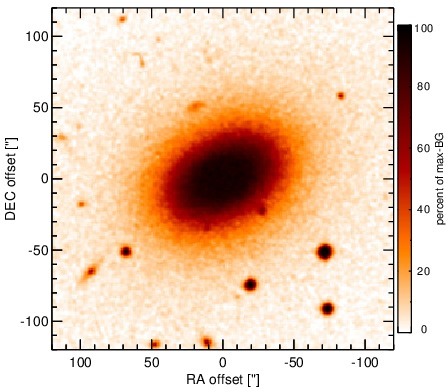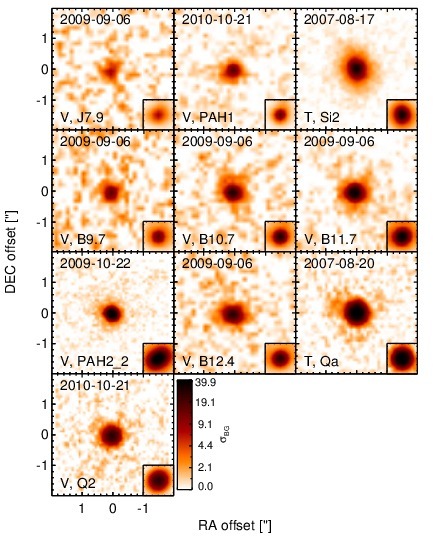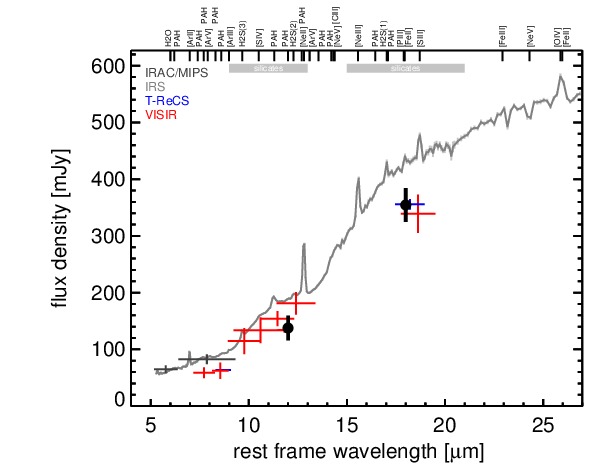Sasmirala Individual Information for NGC 1052
Description
NGC 1052 is a dusty elliptical galaxy at a distance of D = 19.4 ± 1.5 Mpc (NED redshift-independent median) with a radio-loud LINER nucleus with broad polarized lines, a biconical jet (diameter~ 3 pc; PA~ 66∘; [kellermann_sub-milliarcsecond_1998, vermeulen_shroud_2003]) and a flat radio spectrum showing variability by a factor of two in flux [tornikoski_high_2000]. A subparsec-scale dense plasma torus and a water maser around the nucleus have been detected with VLBI radio observations [braatz_discovery_1994, kameno_dense_2001, kadler_twin-jet_2004, sawada-satoh_positional_2008]. NGC 1052 is commonly regarded as the prototypical LINER and has been studied extensively, in particular at radio wavelengths. In the MIR, it was first observed by [kleinmann_observations_1970], [rieke_infrared_1972], [rieke_nonthermal_1982], [becklin_infrared_1982], [willner_infrared_1985], [impey_infrared_1986], and [roche_atlas_1991]. In addition, NGC 1052 was also observed with ISO [sugai_mid-infrared_2000, malhotra_probing_2000, xilouris_dust_2004] and Spitzer/IRAC and IRS [tang_infrared-red_2009, dudik_spitzer_2009]. In the IRAC 5.8 and 8.0 μm images, a compact MIR nucleus embedded within diffuse host emission was detected. Because we measure the nuclear component only, our IRAC fluxes are significantly lower than the total fluxes in [tang_infrared-red_2009]. The IRS LR staring-mode spectrum exhibits silicate 10 and 18 μm emission, a weak PAH 11.3 μm feature and an emission peak at ~ 18 μm (see also [mason_nuclear_2012]). NGC 1052 was observed with T-ReCS in the Si2 and Qa filters in 2007 [mason_nuclear_2012], and with VISIR in six N-band filters in 2009 (unpublished, to our knowledge). In addition, we observed it also with VISIR in PAH1 and Q2 in 2010. A compact MIR nucleus without any other emission was detected in all images. Compared to the corresponding standard star, the nucleus appears resolved in the B10.7, B12.4, PAH1 and Si2 images but not in the others. Apart from the Qa one, none of the observations was performed under diffraction-limited conditions and the obtained FWHMs and PAs are inconsistent. Therefore, it remains uncertain, whether the nucleus of NGC 1052 is in general resolved at subarcsecond resolution in the MIR. The nuclear photometry is on average ~ 25% lower than the Spitzer spectrophotometry, which is indicates that the latter is still affected by diffuse host emission. This extended emission has affected the historical MIR photometry on various levels and thus complicates any comparison of the individual measurements However, we note that in general larger aperture measurements provide higher flux, while comparable apertures yield comparable fluxes. It seems therefore that NGC 1052 has not significantly changed it MIR brightness over the last 40 years. The general MIR SED shape suggests that the silicate emission is originating from the projected subarcsecond-scale nucleus. Thus, warm significant dust is present in the projected central ~ 40 pc of NGC 1052.
- [becklin_infrared_1982] E. E. Becklin, A. T. Tokunaga, and C. G. Wynn-Williams. The infrared emission from the elliptical galaxy NGC 1052 . ApJ , 263 pp. 624–628, December 1982.
- [braatz_discovery_1994] J. A. Braatz, A. S. Wilson, and C. Henkel. The discovery of five new H2O megamasers in active galaxies . ApJL , 437 pp. L99–L102, December 1994.
- [dudik_spitzer_2009] R. P. Dudik, S. Satyapal, and D. Marcu. A spitzer spectroscopic survey of low-ionization nuclear emission-line regions: Characterization of the central source . ApJ , 691 pp. 1501–1524, February 2009.
- [impey_infrared_1986] C. D. Impey, C. G. Wynn-Williams, and E. E. Becklin. Infrared studies of elliptical galaxies. i - an optically selected sample . ApJ , 309 pp. 572–592, October 1986.
- [kadler_twin-jet_2004] M. Kadler, E. Ros, A. P. Lobanov, H. Falcke, and J. A. Zensus. The twin-jet system in NGC 1052: VLBI-scrutiny of the obscuring torus . A&A , 426 pp. 481–493, November 2004.
- [kameno_dense_2001] Seiji Kameno, Satoko Sawada-Satoh, Makoto Inoue, Zhi-Qiang Shen, and Kiyoaki Wajima. The dense plasma torus around the nucleus of an active galaxy NGC1052 . PASJ , 53 pp. 169–178, April 2001.
- [kellermann_sub-milliarcsecond_1998] K. I. Kellermann, R. C. Vermeulen, J. A. Zensus, and M. H. Cohen. Sub-milliarcsecond imaging of quasars and active galactic nuclei . AJ , 115 pp. 1295–1318, April 1998.
- [kleinmann_observations_1970] D. E. Kleinmann and F. J. Low. Observations of infrared galaxies . ApJL , 159 pp. L165, March 1970.
- [malhotra_probing_2000] S. Malhotra, D. Hollenbach, G. Helou, N. Silbermann, E. Valjavec, R. H. Rubin, D. Dale, D. Hunter, N. Lu, S. Lord, H. Dinerstein, and H. Thronson. Probing the interstellar medium in early-type galaxies withInfrared space observatory observations . ApJ , 543 pp. 634–643, November 2000.
- [mason_nuclear_2012] R. E. Mason, E. Lopez-Rodriguez, C. Packham, A. Alonso-Herrero, N. A. Levenson, J. Radomski, C. Ramos Almeida, L. Colina, M. Elitzur, I. Aretxaga, P. F. Roche, and N. Oi. The nuclear infrared emission of low-luminosity active galactic nuclei. AJ , 144 pp. 11, July 2012.
- [rieke_infrared_1972] G. H. Rieke and F. J. Low. Infrared photometry of extragalactic sources . ApJL , 176 pp. L95, September 1972.
- [rieke_nonthermal_1982] G. H. Rieke, M. J. Lebofsky, and J. C. Kemp. Nonthermal optical-infrared emission from NGC 1052 . ApJL , 252 pp. L53–L56, January 1982.
- [roche_atlas_1991] Patrick F. Roche, David K. Aitken, Craig H. Smith, and Martin J. Ward. An atlas of mid-infrared spectra of galaxy nuclei . MNRAS , 248 pp. 606–629, February 1991.
- [sawada-satoh_positional_2008] Satoko Sawada-Satoh, Seiji Kameno, Kayoko Nakamura, Daichi Namikawa, Katsunori M. Shibata, and Makoto Inoue. Positional coincidence of H2O maser and a plasma-obscuring torus in radio galaxy NGC 1052 . ApJ , 680 pp. 191–199, June 2008.
- [sugai_mid-infrared_2000] H. Sugai and M. A. Malkan. Mid-infrared infrared space observatory spectroscopy of the prototypical LINER NGC 1052: Shocks reconsidered . ApJ , 529 pp. 219–223, January 2000.
- [tang_infrared-red_2009] Yuping Tang, Q.-S. Gu, J.-S. Huang, and Y.-P. Wang. Infrared-red cores in nearby elliptical galaxies . MNRAS , 397 pp. 1966–1975, August 2009.
- [tornikoski_high_2000] M. Tornikoski, M. Lainela, and E. Valtaoja. The high radio frequency spectra and variability of southern flat-spectrum radio sources . AJ , 120 pp. 2278–2283, November 2000.
- [vermeulen_shroud_2003] R. C. Vermeulen, E. Ros, K. I. Kellermann, M. H. Cohen, J. A. Zensus, and H. J. van Langevelde. The shroud around the twin radio jets in NGC 1052 . A&A , 401 pp. 113–127, April 2003.
- [willner_infrared_1985] S. P. Willner, M. Elvis, G. Fabbiano, A. Lawrence, and M. J. Ward. Infrared observations of LINER galactic nuclei . ApJ , 299 pp. 443–461, December 1985.
- [xilouris_dust_2004] E. M. Xilouris, S. C. Madden, F. Galliano, L. Vigroux, and M. Sauvage. Dust emission in early-type galaxies: The mid-infrared view . A&A , 416 pp. 41–55, March 2004.
Images

Optical image (DSS, red filter). Displayed are the central 4 arcmin with North being up and East to the left. The colour scaling is linear with white corresponding to the median background (BG) and black to the 0.01% pixels with the highest intensity.

Spitzer MIR images. Displayed are the inner 40 arcsec with North being up and East to the left. The colour scaling is logarithmic with white corresponding to median BG and black to the 0.1% pixels with the highest intensity. The label in the bottom left states instrument and central wavelength of the filter in micron (I: IRAC, M: MIPS).

Subarcsecond-resolution MIR images sorted by increasing filter central wavelength. Displayed are the inner 4 arcsec with North being up and East to the left. The colour scaling is logarithmic with white corresponding to median BG and black to the 75% of the highest intensity of all images in units of sig_bg. The inset image (where present; either bottom or top right) shows the central arcsecond of the PSF from the calibrator star, scaled to match the science target. The labels in the bottom left state instrument and filter names (C: COMICS, M: Michelle, T: T-ReCS, V: VISIR).
SEDs


MIR SED. The description of the symbols in all the SED plots (where present) is the following: Grey crosses and solid lines mark the Spitzer/IRAC, MIPS and IRS data. The colour coding of the other symbols is as follows: green for COMICS, magenta for Michelle, blue for T-ReCS and red for VISIR data. Darker-coloured solid lines mark spectra of the corresponding instrument. The black filled circles mark the nuclear 12 and 18 micron continuum emission estimate from the data (where present). The ticks on the top axis mark positions of common MIR emission lines, while the light grey horizontal bars mark wavelength ranges affected by the silicate 10 and 18 micron features.